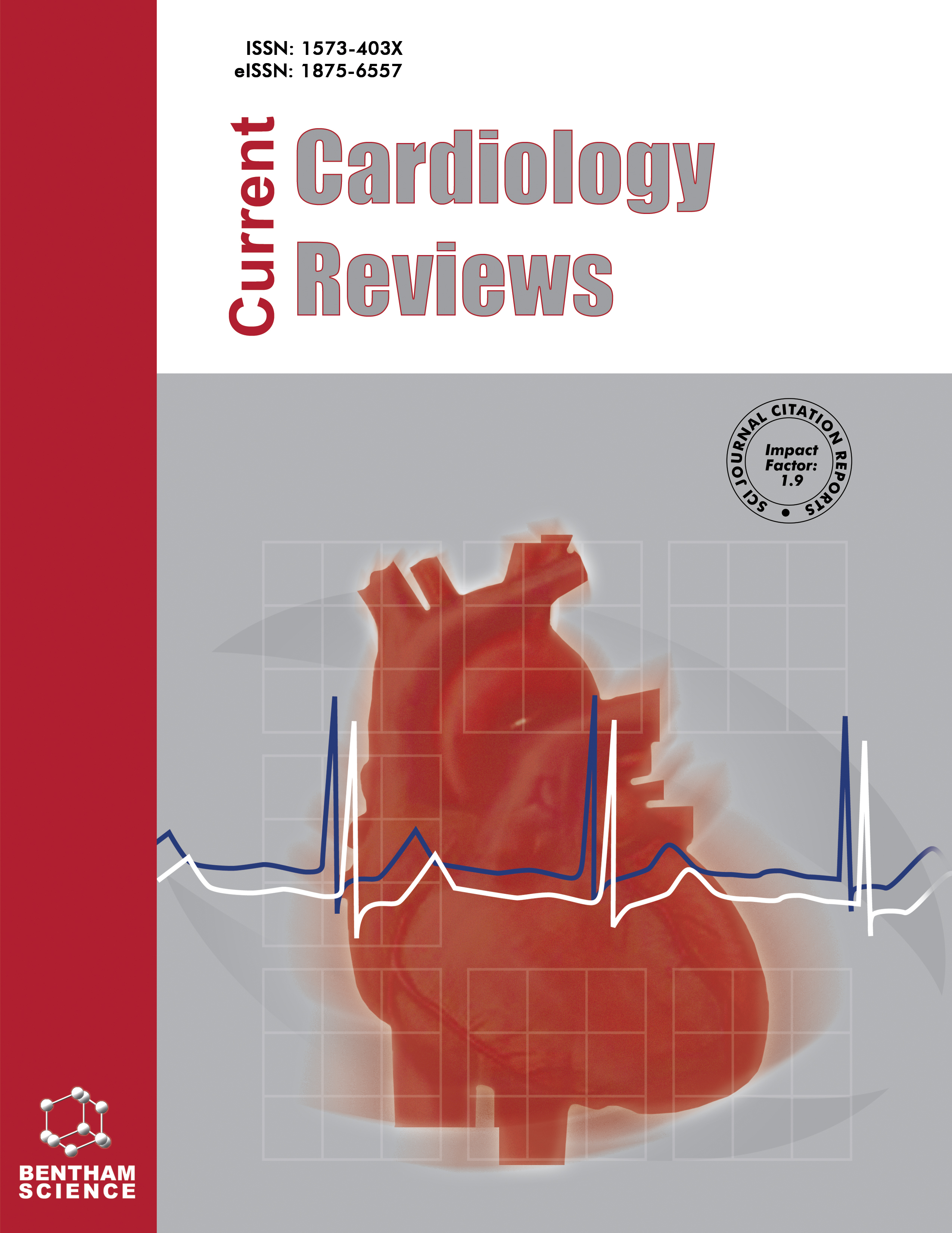- Home
- A-Z Publications
- Current Cardiology Reviews
- Previous Issues
- Volume 17, Issue 6, 2021
Current Cardiology Reviews - Volume 17, Issue 6, 2021
Volume 17, Issue 6, 2021
-
-
Cardiovascular Complications in Major 21st Century Viral Epidemics and Pandemics: an Insight into COVID-19
More LessAuthors: Muzna Hussain, Patrick Collier and Rohit MoudgilThere have many major history-defining epidemics and pandemics in the 21st century. It is well known that acute infections can cause cardiovascular (CV) complications, especially in those with underlying cardiac disease. The variation in rates and types of CVD complications in major 21st century epidemics and pandemics varies greatly. The coronavirus disease 2019 (COVID-19) pandemic has caused the turmoil Read More
-
-
-
Aortic Regurgitation as a Complication of Electrophysiologic Ablation Techniques: A Narrative Review
More LessBackground: Radiofrequency catheter ablation is a well-established treatment for several cardiac arrhythmias. Arrhythmias originating from the left side of the heart including ventricular and supraventricular tachycardia and ectopy can be successfully ablated through either transseptal or retrograde aortic approach. Although these techniques have a generally low rate of complications, aortic valve injury is a potential com Read More
-
-
-
Atrial Natriuretic Peptide: Structure, Function, and Physiological Effects: A Narrative Review
More LessAuthors: Sanjana Rao, Camilo Pena, Scott Shurmur and Kenneth NugentAtrial natriuretic peptide (ANP) is a cardiac peptide with multiple physiological effects, including natriuresis, blood pressure regulation, and renin-angiotensin-aldosterone system (RAAS) antagonism. Pre-proANP is synthesized in the atria and must be extensively cleaved by the protease corin to produce the mature 28 amino acid ANP. The downstream signaling pathway of ANP acts through the guanylyl cyclase receptor and th Read More
-
-
-
Stress and Physical Inactivity: Two Explosive Ingredients for the Heart in COVID-19 Pandemic Times
More LessAuthors: Olívia M. Ruberti, Guilherme Defante Telles and Bruno RodriguesBackground: Coronavirus disease 2019 (Covid-19) pandemic is a global health crisis that has culminated in thousands of deaths. In order to reduce the spread of the Sars-CoV-2 virus, governments of several countries have adopted social isolation as a strategy. However, social isolation has culminated in deleterious effects on the population’s health, including increased physical inactivity, stress and, consequently, adverse ch Read More
-
-
-
Loneliness and Social Isolation: Determinants of Cardiovascular Outcomes
More LessAuthors: Tanya Sharma, Prasad R. Padala and Jawahar L. MehtaOne in three Americans report experiencing loneliness in everyday life, a number that has grown exponentially over the last few decades. As we respond to the SARS-COV2 pandemic with quarantine and social distancing, social isolation and feelings of loneliness are increasing among people of all ages. This presents as an opportune time to recognize the public health impact of these important psychosocial determinants. Lon Read More
-
-
-
Fontan Circulation Might be Associated with Peripartum Cardiomyopathy: A Review of Mechanistic and Clinical Aspects
More LessAuthors: Kenan Yalta, Ertan Yetkin and Gokay TaylanFontan operation has been defined as a palliative surgery connecting systemic venous return and pulmonary circulation in patients with certain forms of complex congenital heart disease (CHD). Fortunately, it has improved overall survival and chance of successful pregnancies among these patients. However, Fontan circulation (FC), as a potential trade-off, might be associated with specific late or post-gestational complicatio Read More
-
-
-
Relationship between Hyperlipidemia, Cardiovascular Disease and Stroke: A Systematic Review
More LessAuthors: Aladeen Alloubani, Refat Nimer and Rama SamaraBackground: Globally, dyslipidemia has been shown to be an independent predictor of many cardiovascular and cerebrovascular events, which led to recent advocacy towards dyslipidemia prevention and control as a key risk factor and its prognostic significance to reduce the burden of stroke and myocardial infarction (MI). Aims: This study aimed to evaluate hyperlipidemia as a risk factor connected with stroke and CVD. Moreo Read More
-
-
-
Efficacy and Safety Outcomes of Short Duration Antiplatelet Therapy with Early Cessation of Aspirin Post Percutaneous Coronary Intervention: A Systematic Review and Meta-analysis
More LessBackground: The optimal duration of dual antiplatelet therapy is a matter of ongoing research. Clinical studies are assessing the optimal duration with the most favourable risk to benefit ratio. The efficacy of P2Y12 receptor inhibitors comparable to aspirin in preventing recurrent ischaemic events in patients with coronary artery diseases. Objectives: To investigate the outcomes of short-duration dual antiplatelet therapy afte Read More
-
-
-
Prognostic Impact of Red Cell Distribution Width on the Development of Contrast-Induced Nephropathy, Major Adverse Cardiac Events, and Mortality in Coronary Artery Disease Patients Undergoing Percutaneous Coronary Intervention
More LessRed cell distribution width (RDW) serves as an independent predictor towards the prognosis of coronary artery disease (CAD) in patients undergoing percutaneous coronary intervention (PCI). A systematic search of databases such as PubMed, Embase, Web of Science, and Cochrane library was performed on October 10th, 2019, to elaborate the relationship between RDW and in hospital and long term follow up, all-cause and car Read More
-
-
-
Safety and Efficacy of Intermittent Hypoxia Conditioning as a New Rehabilitation/ Secondary Prevention Strategy for Patients with Cardiovascular Diseases: A Systematic Review and Meta-analysis
More LessBackground: Once used by mountaineers to facilitate rapid adaptations to altitude and by athletes to improve their aerobic capacity, exposure to hypoxia has been proven to affect various physiological, clinically relevant parameters. A form of conditioning known as Intermittent Hypoxia Conditioning (IHC) consists of repeated exposures to intermittent hypoxia, combined with normoxia and hyperoxia, which has been show Read More
-
Volumes & issues
-
Volume 21 (2025)
-
Volume 20 (2024)
-
Volume 19 (2023)
-
Volume 18 (2022)
-
Volume 17 (2021)
-
Volume 16 (2020)
-
Volume 15 (2019)
-
Volume 14 (2018)
-
Volume 13 (2017)
-
Volume 12 (2016)
-
Volume 11 (2015)
-
Volume 10 (2014)
-
Volume 9 (2013)
-
Volume 8 (2012)
-
Volume 7 (2011)
-
Volume 6 (2010)
-
Volume 5 (2009)
-
Volume 4 (2008)
-
Volume 3 (2007)
-
Volume 2 (2006)
-
Volume 1 (2005)
Most Read This Month
Article
content/journals/ccr
Journal
10
5
false
en


